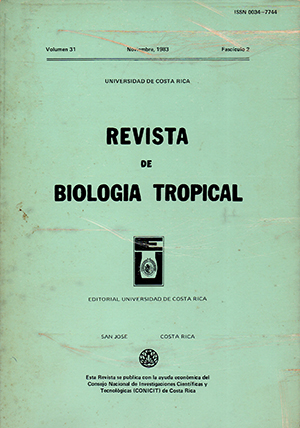Abstract
Twenty-three palmar and digital dermatogliphic characters were examined in two Guaymi Amerindian populations, Abrojo and Limoncito, in southeastern Costa Rica. Dermatogliphs were analyzed in relation to sex, bilaterality or assymetry and differences in pattern frequencies between localities. The sample included 134 males and 127 females in two groups, according to their ethnic and linguistic origin: Western Guaymi (Movere), from Limoncito and Abrojo, and Eastern Guaymi (Murire or Buglere) from Limoncito. When compared with other Amerindian groups, the Guaymi presented a very low finger pattern average, as well a low total ridge count. The Movere subgroup, showed similarities among different patterns both in Limoncito and Abrojo. However there are significant differences between the Murire and Movere groups in relation to the ridge count (ab; bc), atd angle; frequency of designs at the interdigital zone 4; bilaterality; and sex. The results obtained confirm the existence of a marked evolutionary divergence between the two groups.References
Alter, M. 1965. Is hiperploidy of sex chromosomes associated with reduced total finger ridge count? Am. J. Hum. Genet. 17: 473-475.
Barrantes, R. y Azofeifa, J. 1981. Demografía genética de los Amerindios Guaymí de Limoncito, Costa Rica, Rev. Biol. Trop., 29: 123-131.
Barrantes, R., P.E. Smouse, J.V. Neel, H.W. Mohsenwaiser and H. Gershowitz. 1982. Am. J. Phys. Anthrop. 58: 201-214.
Cooke, R. 1982. Los guaymí sí tienen historia. Centro de Estudios y Acción Social. Panamá (CEASPA), Panamá. p. 27-64.
Coope, E., D.F. Roberts. 1971. Dermatogliphic of populations in Latin America, p. 405-453. In F.M. Salzano, (ed.). The ongoing evolution in Latin American populations. Charles C. Thomas, Chicago.
Cummins, H. y C. Midlo. 1961. Finger prints palms and soles: an introduction to dermatoglyphics. Dover press, New York, 319 p.
Fitch, W.M. y J.V. Neel. 1969. The phylogenetic relationship of some Indian tribes of Central and South America. Amer. J. Hum. Genet., 21: 284-297.
Forbes, A.P. 1964. Fingerprints and palm prints (dermatoglyphics) and palmar flexion creases in gonadal dysgenesis, pseudohypoparathyroidism and Klinefelter's syndrome. N. Engl. J. Med., 270: 1268-1277.
Hoff, C., C.C. Plato, R.M. Garruto, & J. Dutt. 1981. Dermatoglyphic assesment of the genetic relationships of native American Populations. Am. J. Phys. Anthrop. 55: 455-461.
Holt, S.B. & J. Lindsten. 1964. Dermatoglyphic anomalies in Turner' syndrome. Ann. Hum. Genet., 28: 87-100.
Johnson, F. 1 948. The Caribbean Lowland tribes. The Talamancan division, p. 231-251. In J.H. Steward (ed.): Handbook of South American Indians, Vol. 4. Washington, D.C. U.S. Goverment Printing Office.
Linares, O. & A. Ranere. 1980. Adaptative radiation in Prehistoric Panama. Peabody Museum Press, Harvard, 530 p.
Rothhammer, F., J.V, Neel, F. Da Rocha & G. Y. Sundling. 1973. The genetic structure of a tribal population, the Yanomama indians. VIII. Dermatoglyphic differences among villages. Amer. J. Hum. Genet., 25: 152-166.
Rothhammer, R., R. Chakraborty, & E. Llop. 1977. A collation of marker gene and dermatoglyphic diversity at various levels of population differentiation. Am. J. Phys. Anthropol. 46: 51-60.
Spielman, R.S., E.C. Migliazza, J.V. Neel, H. Gershowitz & R. Torres. 1979. The evolutionay relationships of two populations: A study of the Guaymi and the Yanomama. Current Anthrop. 20: 377-388.
Torres de Arauz, R. 1980. Panamá indígena. Instituto de Cultura, Panamá. p. 215-270.
Young, P.D. 1971. Ngawbere: Tradition and change among the western Guaymi of Panamá. Urbana: University of Illinois Press, 257 pp.
Young, P.D. & J.R. Bort. 1979. The politicization of the Guaymi. J. Steward, Anthrop. Soc. 11: 73-110.
##plugins.facebook.comentarios##

This work is licensed under a Creative Commons Attribution 4.0 International License.
Copyright (c) 1983 Revista de Biología Tropical






